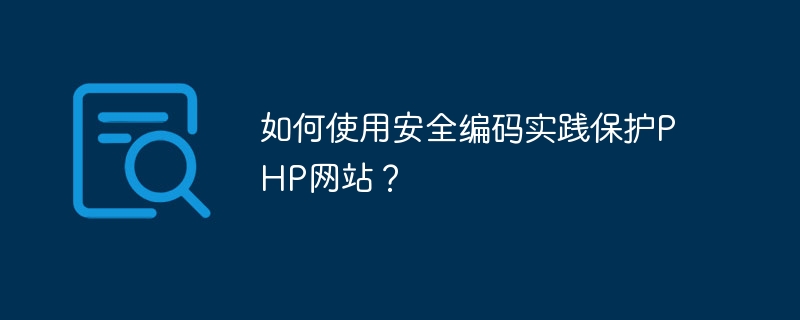Home >Backend Development >PHP Tutorial >How to protect your PHP website using secure coding practices?
How to protect your PHP website using secure coding practices?
- WBOYWBOYWBOYWBOYWBOYWBOYWBOYWBOYWBOYWBOYWBOYWBOYWBOriginal
- 2023-08-20 18:05:111195browse

How to protect your PHP website using secure coding practices?
With the popularity and development of the Internet, more and more websites use PHP as the development language. However, PHP's flexibility and ease of use also make it vulnerable to various security threats. Therefore, when developing a PHP website, it is essential to apply secure coding practices to protect the website from possible attacks. This article will introduce some ways to protect your PHP website using secure coding practices and provide corresponding code examples.
- Input validation and filtering
Input validation and filtering are the first line of defense to protect PHP websites and can prevent malicious users from submitting malicious and illegal data. The following are some commonly used input validation and filtering methods:
(1) Filter function
$username = filter_var($_POST['username'], FILTER_SANITIZE_STRING); $email = filter_var($_POST['email'], FILTER_SANITIZE_EMAIL);
(2) Regular expression
if (preg_match("/^[a-zA-Z0-9]*$/", $username)) {
// 验证成功
} else {
// 验证失败
}- Prevent SQL injection attacks
SQL injection attack means that the attacker uses the input point of the website to insert malicious SQL code to obtain or modify the data in the database. In order to prevent SQL injection attacks, the following measures can be taken:
(1) Use prepared statements
$stmt = $pdo->prepare("SELECT * FROM users WHERE username = :username");
$stmt->execute(['username' => $username]);
$result = $stmt->fetch();(2) Use parameterized query statements
$stmt = $pdo->prepare("SELECT * FROM users WHERE username = ?");
$stmt->execute([$username]);
$result = $stmt->fetch();- Prevent Cross-site scripting attack (XSS)
Cross-site scripting attack refers to an attacker obtaining sensitive information of users by injecting malicious scripts on the website. To prevent XSS attacks, you can take the following measures:
(1) Escape or encode special characters
$name = htmlspecialchars($_POST["name"]);
(2) Use the HTTP header to set X-XSS-Protection
header('X-XSS-Protection: 1; mode=block'); - Preventing Cross-site Request Forgery (CSRF)
Cross-site request forgery means that an attacker uses the identity of a logged-in user to perform certain malicious operations without the user's knowledge. . To prevent CSRF attacks, the following measures can be taken:
(1) Generate tokens for each form
$token = uniqid(); $_SESSION['csrf_token'] = $token;
(2) Verify tokens
if ($_POST['csrf_token'] !== $_SESSION['csrf_token']) {
// 验证失败,可能是CSRF攻击
exit;
}- Use Secure password storage method
If the user's password is leaked or decrypted, it will lead to serious security issues. Therefore, secure storage methods such as hash functions and salting should be used when storing user passwords.
$salt = 'randomsalt';
$password = 'password';
$hashedPassword = hash('sha256', $salt . $password);To sum up, using secure coding practices can effectively protect your PHP website from various security threats. The security of your PHP website can be improved through measures such as input validation and filtering, preventing SQL injection attacks, preventing XSS attacks, preventing CSRF attacks, and using secure password storage methods. However, please note that these methods only provide some basic protection measures, and further research and practice are still needed for more complex security issues.
The above is the detailed content of How to protect your PHP website using secure coding practices?. For more information, please follow other related articles on the PHP Chinese website!

